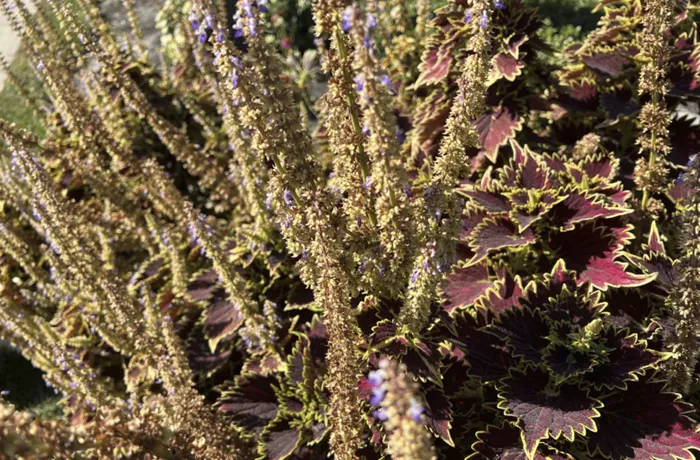Lately, I’ve been taking my 12-year-old Havanese, Miguel, on daily 3,500-step walks around our suburban New York neighborhood. As we go, I’ve noticed how some plants are changing as the weather cools down. It’s not just the usual signs of autumn—deciduous trees shedding leaves or perennials wilting. Some plants, typically known for their foliage, are blooming at unexpected times.
The Surprising Late-Season Flowers
One example is coleus, a plant usually grown for its colorful leaves, which can be maroon with chartreuse edges. But right now, my neighborhood’s coleus plants are showing off 2 1/2-foot spikes of small purple flowers. While these blooms are striking, they might not be what the owners were hoping for. After all, the flowers aren’t what you typically see on nursery plant tags or catalog photos.
Another plant that surprises with its flowers is the caladium, known for its large, heart-shaped leaves in shades of red, pink, and white. While the plant is usually grown for its foliage, it also produces small white or pink flowers resembling a cross between a calla lily and a flamingo flower. These flowers aren’t always welcome, so many gardeners remove them to help the plant focus its energy on growing leaves.
Similarly, Alocasia, or elephant ears, a close relative of the caladium, also blooms late in the season. However, its flowers are smaller and less consistent.
Flowers That Some Gardeners Remove
Many gardeners remove the flower spikes of hostas, a habit that puzzles me since I love the purple or white flowers they produce. For me, these blooms are the highlight of the plant.
Lamb’s ear, known for its soft, velvety silver leaves, also produces pinkish-purple flowers in late summer. While some people prefer to remove these flowers to focus on the foliage, I think the blossoms add an extra touch to the plant’s beauty.
Rex begonias, often grown in shady spots both outdoors and indoors, are known for their striking, patterned foliage. While their leaves come in a mix of red, pink, purple, and silver, the small pink or white flowers tend to get overlooked or considered less impressive.
Liriope, or monkey grass, is another plant that surprises with its flowers. In late summer, it produces small purple or white flowers, which eventually turn into dark berries in the fall. However, gardeners should be careful, as Liriope spicata, a variety I planted by mistake, has invasive roots that can quickly spread throughout the garden.
Early-Season Flower Surprises
Some plants, like Siberian bugloss (Brunnera), catch you off guard in spring. Known for its striking green and silver foliage, this plant brightens shady gardens early in the year. In spring, it also produces small, light blue flowers.
Boxwoods, usually valued for their dense evergreen foliage, bloom in spring as well. Their tiny yellow-green flower clusters are often unexpected and sometimes concerning to owners.
Heuchera, or coral bells, is another plant with flowers that often take a back seat to its foliage. The plant’s leaves come in a range of colors, from red to copper to purple, and they are the main reason gardeners love it. The flowers, which appear on tall spikes in late spring and summer, are often mismatched with the foliage and can be a bit unattractive. It’s best to check the flower color of any Heuchera variety before deciding to plant it.
Related topics:


